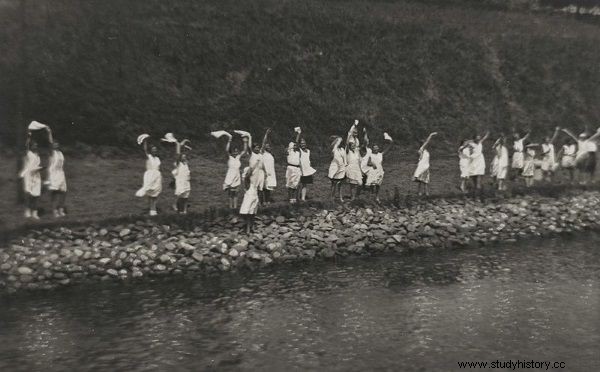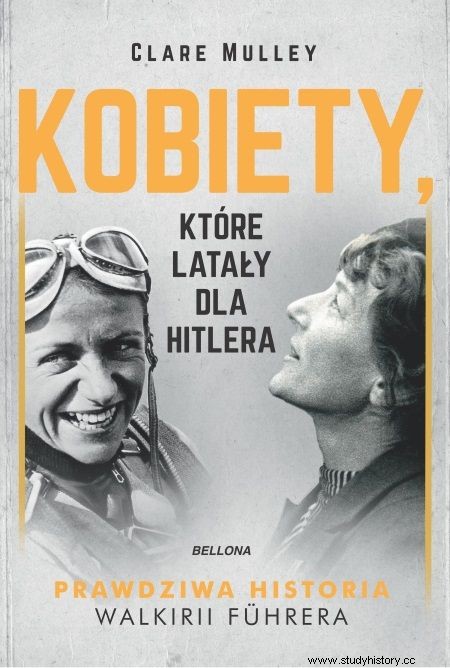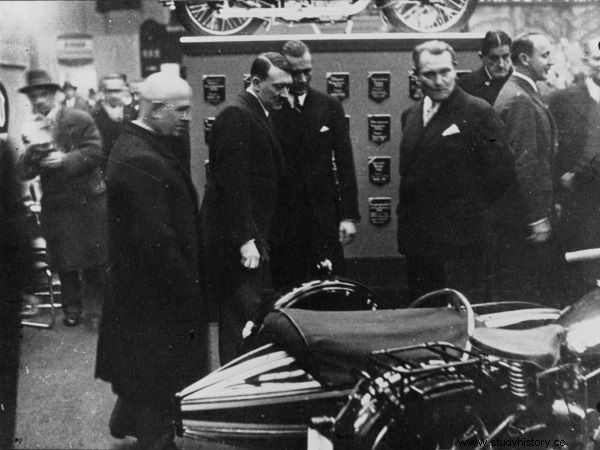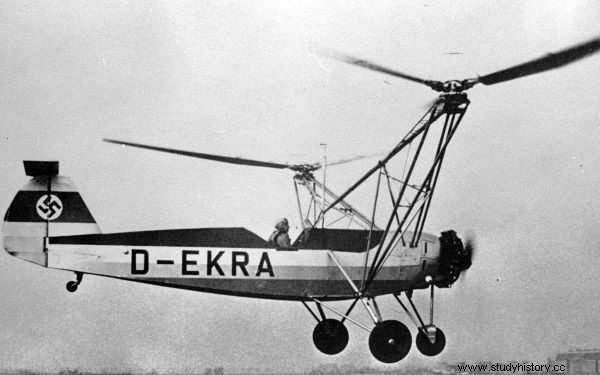At a time when the ideal German woman was to take care of the house and bear children, she wanted to fly. When she was finally allowed to take the controls, she amazed everyone, including Hitler, who was the last person alive to leave the bunker.
Hanna Reitsch was born on March 29, 1912 in Hirschberg, which is today's Jelenia Góra. Although she was passionate about aviation from an early age, as a German she had a closed road to it.
Under the terms of the Treaty of Versailles, her homeland could not have its own air fleet, aviation industry and machines adapted to high altitude flights. Enthusiasts who wanted to get away from the ground had to be content with gliders. Hanna was to sit at the helm of them in the future. But first she had to get permission from her parents.
The young Miss Reitsch had an overbearing father, Willy, who initially refused to hear about his daughter's plans. Anyway, a girl in junior high school dreamed of two things - studying medicine (her father was a doctor and he instilled a passion in her) and flying. Her parents thought she was a bastard who would quickly wind up such ideas, so Willy offered her a deal - he would let her get on the plane if she didn't mention it for two years. During this time, Hanna started learning, and when she received a gold watch from her father on the occasion of passing her high school exams, she reminded him of the pact and asked for her promised gliding course.
Kinder, Küche, Kirche? No thanks
Before she left for college, her mother forced her to study at the Colonial School for Women in Rendsburg. The very idea of this post was quite absurd, because Germany lost its colonies in the aftermath of the Great War. As a result of the revisionist dreams, neither the name of the school nor its curriculum was changed.

Students of the Rendsburg Colonial School for Girls (photo:public domain).
Young girls were taught, among other things, cleaning, cooking, housekeeping, basic household repairs, several languages (English, Spanish and… one of the West African languages). As Clare Mulley writes in the book "Women Who Flew for Hitler" :
Her "only significant success", she scoffed afterwards, was a private experiment with hygienic pig farming.
In the mother's mind, education at this school was not only meant to teach her daughter to be a good housewife. There was a maritime college nearby, attended by a whole host of young men. Mrs. Reitsch hoped Hanna would come back with her diploma, but also with the right fiancé. The family's plans came to naught, because the girl only dreamed of flying.
When she first showed up at the pilot school in the mid-1930s, she did not impress her friends with her posture. She was less than one hundred and fifty-five centimeters tall, weighed just over forty kilograms. She had blue eyes, fair hair, a wide smile on her face, and was the only girl among the students. Before she got the first time at the controls of the glider, she had to put up with the taunts of her colleagues. However, she quickly rubbed their noses.

You can learn about the fate of Hanna Reitsch in the book Clare Mulley "Women Who Flew for Hitler" , which has just been released by Bellona.
One of the first exercises was dry flying, so that the trainees would learn to keep their balance. To this end, they were supposed to glide down the hillside with a glider, pushed out by their colleagues. When it was time for Hanna, the gentlemen did not correct her posture, which gave her a quite powerful start. In addition, the girl jerked the stick, and then ... completely without preparation, she broke away from the ground and glided. The whole thing could have ended tragically, if not for the instructor's reaction, who in time shouted to the surprised student:"Down!".
When she was on the ground, the impact force was so great that she tore her from the seat belts and threw her out of the cabin. She almost broke her neck. Hanna took this as a valuable lesson. Later, her progress in piloting was lightning fast. The talent was so clear that the head of the school soon became interested in her and started giving her private lessons. Soon her skills were sufficient to become an instructor herself. Slowly, Hanna was also gaining recognition and publicity.
A celebrity goes to Rio
Wanting to use its potential, after the end of the aviation competition in which she participated, the head of the German Institute for the Development of Gliding invited her to participate in an expedition to South America. Hanna was a great advertisement. Dressed in white, she performed gliding acrobatics for days. One day she even made a mistake and had to end up in the middle of the soccer field in Rio de Janeiro, where ... the game was just underway. While she should have been reprimanded for it, her forced landing was a marketing success and was reported in detail by the local press for weeks.
After returning from Brazil in 1934, Hanna trained in Szczecin at the School of Civil Aviation, which was a forge of staff for the Luftwaffe established a year later. Miss Reitsch was also involved in an aviation film whose heroine was loosely modeled on her. As part of her role, she could fly for hours or repeatedly land a glider in the lake ... And she was paid for it!

Hanna Reitsch in South America (photo:public domain)
With the growing role of aviation in Germany, more shows began to be organized. Clare Mulley, author of The Women Who Flew for Hitler quotes the wife of a friend of Hannah's friend, which shows this change perfectly:
Hitler wanted Germany to become a nation of aviators. If there was any celebration in the city, the air show was compulsory. " Karl was working with Hanna on an acrobatic program, and soon she was running a series of shows throughout Germany's regional aviation days, performing aerobatics to entertain the crowds.
Hanna Reitsch was not only a great aviator. She also began to gain the status of a celebrity. Articles were written about her, her ruddy face smiled from the covers of magazines. Her photo was even on the collector's card from the series "Contemporary beauties" attached to cigarettes. Eventually, Hanna publicly began to support the new government and as a result climbed up the career ladder, benefiting from the protection of high-ranking Nazis.
She started working as a test pilot for new machines and tested various technical solutions that the German air force was to use in the future. Friends who appreciated her skills introduced her to the most influential circles of the Luftwaffe, and her mentor was Ernst Udet, the second most effective German pilot from World War I (28 confirmed kills) after the "Red Baron".

Hitler and Göring at the Berlin Motor Show in 1933 (photo:public domain)
It was Udet who began his efforts to ensure that Hanna was awarded the honorary title of flug-captain (air captain), which was awarded to people who were especially distinguished for the development of aviation in Germany. It was on the day she was decorated with the medal that she met Adolf Hitler for the first time.
Does everything "by Hitler's authority"
When Germany started the war, Hanna was still working as a test lab. As Dennis Piszkiewicz writes in the book "Sky flights by Hanna Reotsch", she flew on anything with wings and propellers . First of all, it constantly tested new solutions for the Luftwaffe. She did not take note of Blitz's horror, and found the news of Nazi crimes to be hideous slander. What mattered for her, as she commented years later, was saving the lives of German pilots who too often died due to design flaws in their aircraft.
Once, by testing the device for cutting the supporting ropes used by the English balloon barriers, she almost paid for her flight with her life. The device cut the line, but it also damaged one of the bomber's propellers. As her plane disappeared behind the line of trees, Ernst Udet, who watched the show, expected the sound of impact and explosion. Meanwhile, Hanna, thanks to her phenomenal skills, managed to land safely at the airport several kilometers away. Udet told Hitler about her exploits.
On March 27, 1941, the woman was summoned to Hermann Göring. The Reich Marshal pinned a diamond badge on her breast. The next day, Hitler himself received it at the Reich's office and decorated it with the Second Class Iron Cross. Hanna Reitsch became the pet of the high-ranking Nazis, and when she came to her hometown a few days later, she was celebrated as a national heroine and granted honorary citizenship.

Hanna Reitsch flying Focke-Wulf Fw 61 (photo:ADL, license from DNU FDL)
Hanna used the newly gained position in her own, slightly crazy way. She was truly obsessed with flying. She invited herself and was involved as a tester in all aviation-related projects, arguing that she was doing it on behalf of Hitler. One of her friends from the time of gliding summed it up in a strongly sexist, but emphatic way. His statement is quoted by Clare Mulley in the book "Women Who Flew for Hitler" :
There are some women who can't stand that there's a new guy in town and they haven't had him in bed yet. It's exactly the same with Hanna, except it's about airplanes. Every time a new prototype comes out, he becomes obsessed with it and can't sit still until he flies it.
During the rocket flight, the aviator amazed Otto Skorzenny with his courage, known for having led several daring commando actions. Upon hearing of her enthusiasm, he said: Hanna, j if whatever happens to you, the Führer will personally tear me to pieces!
Though the pilot seemed fearless, there was something that made her panic. As other pilots from the Messerschmitt aircraft plant in Regensburg, where she worked, found out, the pilot was terribly afraid of mice. One day after entering the canteen, she made a terrible scream and climbed onto the chair. Colleagues must have caught the rodent before she agreed to return to earth…

Ernst Udet in 1918 (photo:public domain)
Hanna's most important mission, however, was to come in the last days of the war. When the Reich began to have more and more trouble on the fronts, the figure of the pilot, who finally became the first woman of the 1st class Iron Cross, began to be used for propaganda purposes. She even went to the eastern front to raise the morale of soldiers there by flying to the farthest outposts by plane.
In the spring of 1945, when the Soviets were tightening the ring around Berlin, she and her friend made a desperate attempt to break into the besieged city and get Hitler out. As a star of the Luftwaffe and a devoted Nazi, she spent several days in a bunker under the Reich's office where the Führer was hiding. She then pleaded with Hitler to let her leave Berlin, but he had completely lost touch with reality and ordered Hanna to fly away. As writes Clare Mulley :
Russian floodlights now flooded the main thoroughfares with light, as well as poking around the sky above the burning city. Once they were in the air, the arado [the plane they flew - ed. ed.] stumbled upon a wall of fire - it was the soldiers of the Soviet 3rd Strike Army who fired whatever they had at hand, fearing that Hitler was fleeing.
The Führer, however, was not on that plane. In the cockpit sat Hanna Reitsch, whom the leader of the Third Reich had forbidden to stay with him in the bunker, and her wounded friend. On April 30, Hitler committed suicide. And a few days later, Hanna was captured in the US.
Learn the extraordinary story about the pilots who flew to the glory of the Third Reich:

